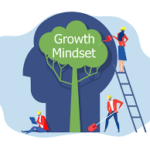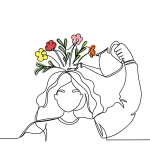Doodling, often dismissed as a mindless activity, has been gaining recognition as a potent stress relief technique. In this article, we’ll delve into the origins of doodling, explore its psychological underpinnings, examine scientific studies supporting its stress reduction benefits, and provide practical tips on incorporating doodling into daily life.
I. Introduction
A. Definition of Doodling
Doodling is the spontaneous act of drawing, scribbling, or sketching, often unconsciously, while the mind is occupied with other thoughts or tasks. It’s a form of expression that transcends language, allowing individuals to communicate with themselves through images and patterns.
B. Popularity of Stress Relief Techniques
In a fast-paced world filled with constant challenges, stress relief techniques have become essential for maintaining mental well-being. People are actively seeking alternative methods beyond traditional therapies, leading to a surge in interest in activities like doodling.
II. Historical Perspective
A. Origins of Doodling
The roots of doodling can be traced back to ancient civilizations where individuals would make spontaneous marks during moments of contemplation. Over time, doodling evolved from a cultural practice into a personal expression of creativity and, inadvertently, a stress-relief method.
B. Evolution as a Stress-Relief Method
As societies evolved, so did the significance of doodling. It transformed from a mere pastime into a recognized coping mechanism for stress. Understanding the historical context provides insights into why doodling remains a prevalent practice today.
III. Psychology of Doodling
A. Subconscious Expression
Doodling often taps into the subconscious, allowing individuals to express thoughts and emotions they might not be consciously aware of. The free-flowing nature of doodles can unveil hidden aspects of the mind, contributing to self-discovery and stress release.
B. Neurological Impact
Neurologically, doodling engages both hemispheres of the brain, promoting a balanced cognitive process. Studies suggest that this bilateral stimulation can have a calming effect on the mind, making doodling an effective tool for stress reduction.
IV. Doodling and Stress Reduction
A. Distraction from Stressors
One of the primary benefits of doodling is its ability to distract the mind from stressors. By providing an outlet for creative expression, doodling redirects attention and offers a brief respite from anxiety-inducing thoughts.
B. Enhancing Mindfulness
Engaging in the act of doodling encourages a state of mindfulness, where individuals focus on the present moment without judgment. This mindfulness not only alleviates stress but also cultivates a sense of tranquility.
V. Scientific Studies
A. Research on Doodling and Stress
Numerous scientific studies have explored the relationship between doodling and stress reduction. Researchers have consistently found positive correlations, indicating that incorporating doodling into daily routines can lead to a measurable decrease in stress levels.
B. Findings and Conclusions
From controlled experiments to longitudinal studies, the scientific community has amassed compelling evidence supporting doodling as a viable stress relief technique. These findings lay the foundation for understanding the role of doodling in mental well-being.
VI. Incorporating Doodling into Daily Routine
A. Tips for Effective Doodling
For those new to doodling, adopting a few simple tips can enhance the experience. Experiment with different doodling styles, choose the right tools, and find a comfortable environment to unleash creativity.
B. Integrating into Work and Leisure
Doodling isn’t limited to specific settings. Whether at work or during leisure activities, finding moments to doodle can seamlessly integrate stress relief into daily routines.
VII. Benefits Beyond Stress Relief
A. Boosting Creativity
Doodling isn’t just about stress relief; it’s also a powerful tool for boosting creativity. Engaging in this spontaneous activity can unlock innovative thinking and enhance problem-solving skills.
B. Improving Focus and Concentration
Contrary to common misconceptions, doodling can enhance focus and concentration. It serves as a supplementary outlet for excess mental energy, allowing individuals to maintain attention during tasks.
VIII. Doodling Tools and Techniques
A. Best Materials for Doodling
Choosing the right materials can significantly impact the doodling experience. From traditional paper and pens to digital tools, each medium offers a unique approach to the art of doodling.
B. Advanced Doodling Techniques
For those seeking to take doodling to the next level, exploring advanced techniques such as zentangle patterns or mandala creation can add depth and complexity to the practice.
IX. Personal Stories
A. Real-Life Experiences with Doodling
Sharing personal stories of individuals who have incorporated doodling into their lives provides firsthand accounts of the positive impact on stress levels. These anecdotes offer inspiration and validation for those considering doodling as a stress relief method.
B. Positive Impact on Stress Levels
Highlighting specific instances where doodling has made a tangible difference in managing stress reinforces the article’s premise. These stories contribute to the narrative of doodling as a practical and effective stress-relief tool.
X. Addressing Common Misconceptions
A. Dispelling Myths About Doodling
As with any unconventional practice, doodling has its fair share of myths. Addressing common misconceptions ensures that readers approach doodling with accurate information and an open mind.
B. Clarifying Its Role in Stress Management
Clarifying the specific role doodling plays in stress management helps dismantle skepticism. By emphasizing its scientific backing and real-world applications, the article builds a strong case for incorporating doodling into stress relief routines.
XI. Doodling for Specific Stress Triggers
A. Tailoring Doodling to Individual Needs
Not all stress triggers are the same. Tailoring doodling to address specific stressors provides readers with a personalized approach to using this technique effectively.
B. Case Studies on Targeted Stress Relief
Examining case studies where individuals have successfully used doodling to address specific stress triggers adds depth to the article. These examples illustrate the versatility of doodling as a customizable stress-relief method.
XII. Doodling Apps and Communities
A. Online Platforms for Doodlers
The digital age has brought forth a plethora of doodling apps and online communities. Exploring these platforms allows readers to connect with like-minded individuals, share creations, and discover new techniques.
B. Connecting with Like-Minded Individuals
Building a sense of community around doodling fosters engagement and inspiration. Connecting with others who share a passion for doodling creates a supportive network for individuals exploring this stress relief method.
XIII. Future of Doodling as a Stress Relief Technique
A. Potential Developments and Innovations
The future holds exciting possibilities for doodling as a stress relief technique. From technological advancements to innovative approaches, staying informed about potential developments ensures readers are at the forefront of this evolving practice.
B. Integration into Mental Health Practices
As the mental health landscape evolves, integrating doodling into formal mental health practices is a logical progression. Exploring the potential collaboration between doodling and therapy opens avenues for holistic well-being.
XIV. Critics and Skeptics
A. Addressing Skepticism Around Doodling
Not everyone is convinced of the benefits of doodling. Acknowledging and addressing skepticism head-on allows readers to make informed decisions about incorporating doodling into their stress relief strategies.
B. Counterarguments and Supporting Evidence
Presenting counterarguments and supporting evidence offers a balanced perspective. By weighing the criticisms against the existing body of research, readers can form their own conclusions about the efficacy of doodling for stress relief.
XV. Conclusion
A. Recap of Key Points
In conclusion, doodling, often underestimated, emerges as a powerful and accessible stress relief technique. From its historical roots to the latest scientific studies, the evidence overwhelmingly supports the role of doodling in promoting mental well-being.
B. Encouragement to Explore Doodling for Stress Relief
As readers reach the end of this article, the encouragement to explore doodling for stress relief is paramount. The accessibility, versatility, and scientifically-backed benefits make doodling a valuable addition to one’s toolkit for managing stress.
FAQs
- Is doodling suitable for everyone, regardless of artistic skill?
- Absolutely! Doodling is a personal expression, and artistic skill is not a prerequisite for experiencing its stress-relief benefits.
- Can doodling be integrated into a busy work schedule?
- Yes, doodling can be seamlessly integrated into breaks or moments of reflection, making it adaptable to even the busiest schedules.
- Are there specific doodling techniques recommended for stress relief?
- While any form of doodling can be beneficial, certain techniques, such as repetitive patterns or mandalas, are known for their calming effects.
- Is digital doodling as effective as traditional paper and pen doodling?
- Both traditional and digital doodling have their merits. The effectiveness depends on personal preference and comfort.
- How long does it take to experience the stress-relief benefits of doodling?
- The timeframe varies from person to person, but many individuals report a sense of calm and relaxation after just a few minutes of doodling.









